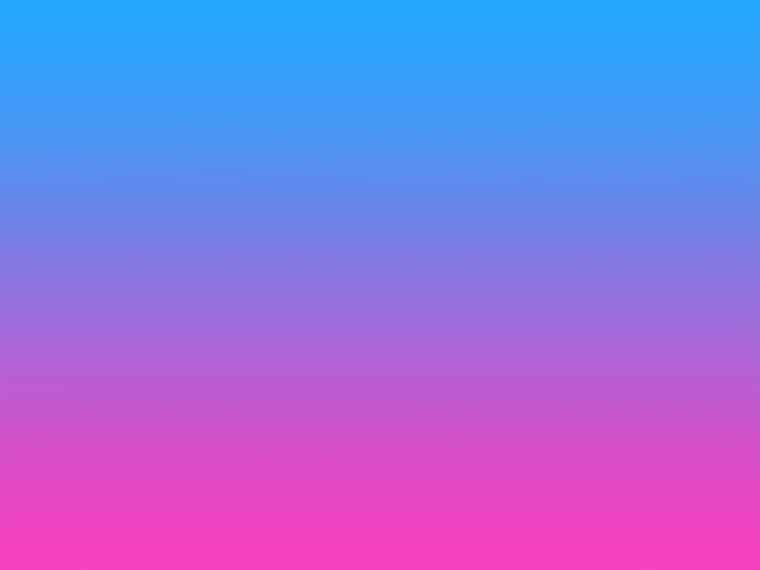Are you wondering what color blue and pink make when mixed? Most likely, you’ll end up with something between blue and red on the color wheel. Let’s find out more.
Blue and pink are two of the most loved colors worldwide. Many people consider either of them their favorite color. It’s no wonder. Both have a rich history as baby colors.
We’re continuing our series on mixing colors, and today we’re going to answer a great curiosity: “Pink and blue make what color when mixed?” Interestingly, pink is a light version of red, and together with blue, it’s like a mix between a desaturated primary color and another primary color.
But what color do blue and pink make when mixed? We answer that question in today’s article. And not only will we answer it in detail, but we’ll also discuss how to mix them.
What Color Do Blue and Pink Make in Paint?
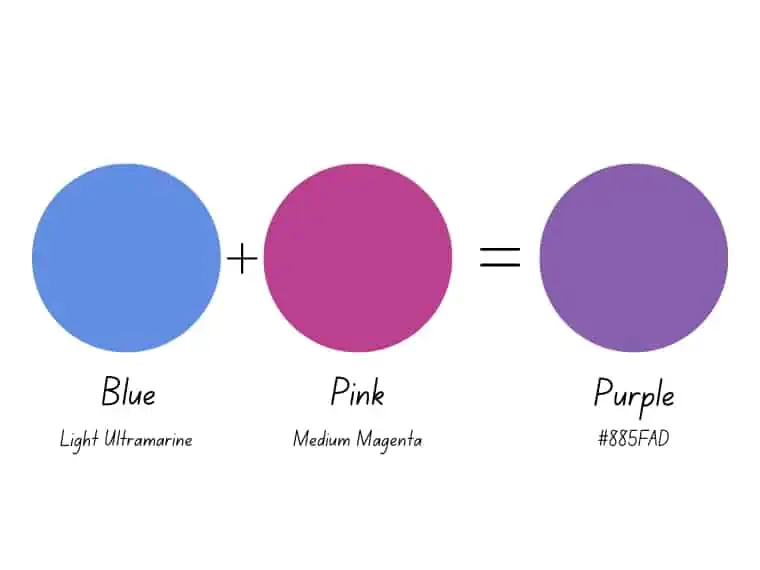
When you mix blue and pink paint, you get a purple color. This can vary depending on the paint chosen, from a lighter shade like lilac and lavender to bolder shades like royal purple.
Blue is a primary color, while pink is a tint of red or a paler version. So it’s like a mix of blue and red in a lighter version.
Although mixing pink and blue makes a shade of purple, the easiest way to get a vibrant purple is by mixing blue and red.
This mix will save you time and effort. You can also create lighter shades of purple by mixing blue and red. Simply add white paint to the final mixture until you reach the desired shade.
However, you can mix blue and pink to create a lighter or pastel version of purple, but you need a little experience.
How Can You Mix Pink and Blue?
Wondering how to mix blue and pink? Let’s first see what color theory says.
Blue is a cool color, bringing water, ice, snow, and cold to mind.
On the other hand, pink is a warm color because it is a tint of red. That means it’s a paler version of red, made by mixing the primary color red with white. However, there are also cool pinks, which contain a lot of white (baby pink) or a little blue (hot pink).
Do they pair well together? Blue and pink go well together if you choose the right tones.
Is it Difficult to Get the Perfect Purple Mix?
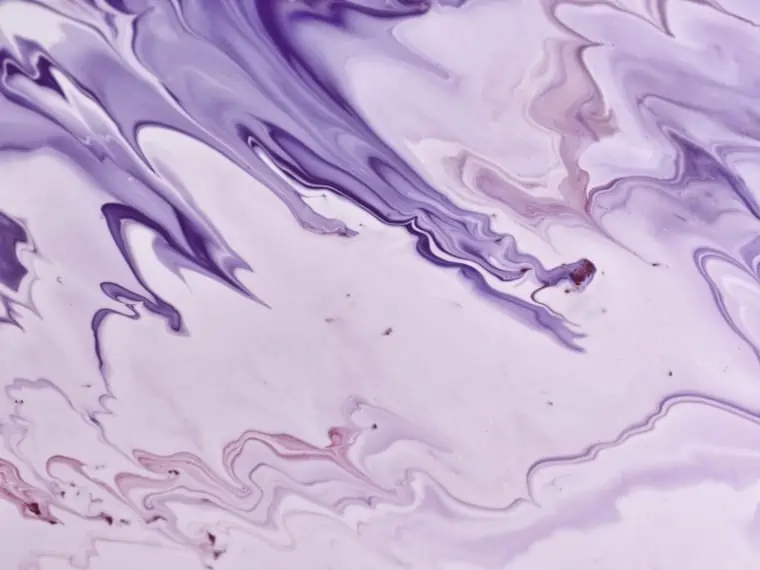
Yes, it is. Even if you mix blue and pink or blue and red, getting a perfect purple is quite difficult. Often you’ll end up with a purple-brown rather than a vibrant purple.
This does not necessarily take into account the proportions of paint used, but the purity of the colors.
That’s because pigments and dyes come in different shades. For example, blue can be Cerulean, Ultramarine, or Cobalt; On the other side, pink can be Permanent rose, Medium magenta, or Light magenta.
Some blues or even reds contain a little yellow. And if you mix red, yellow, and blue, you get brown. So finding pure colors is challenging.
Making Tints and Shades by Mixing Pink and Blue
Here is an infographic showing what colors mix blue and pink paint. Specifically, mixing different blue paints with light and medium magenta.
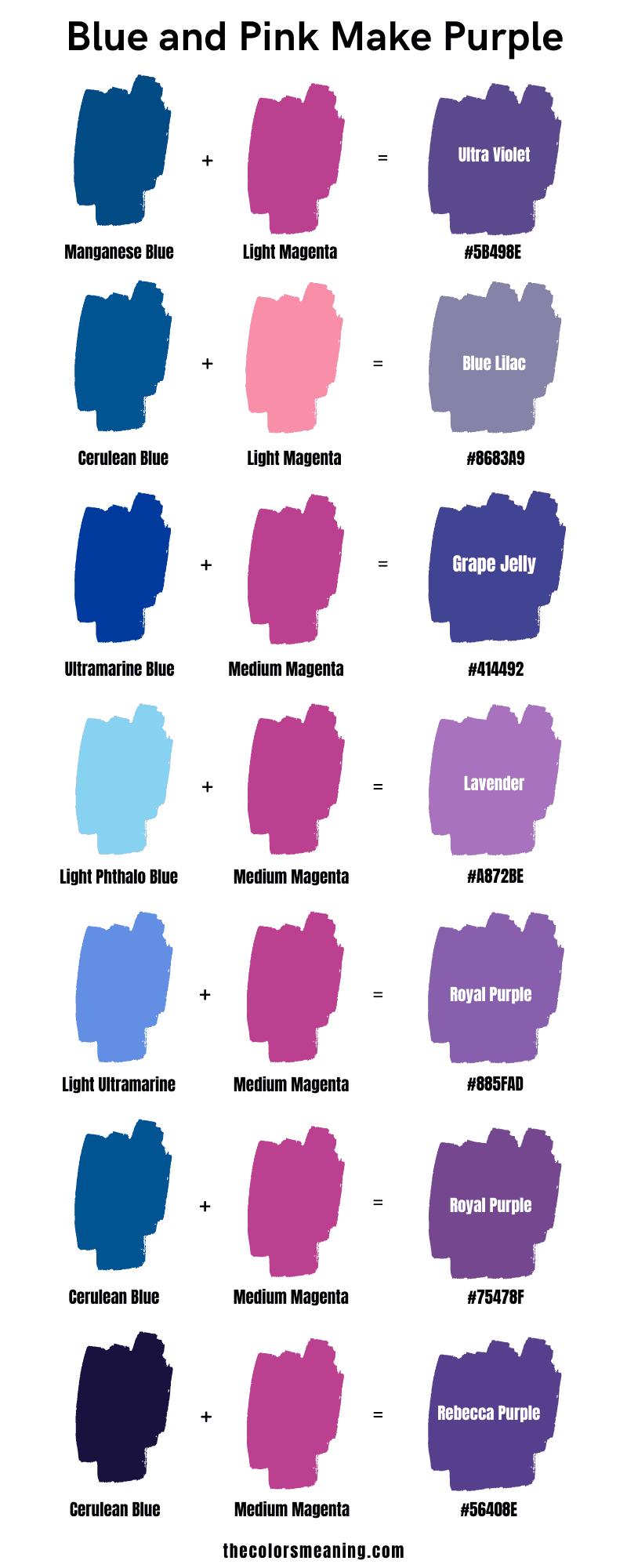
Purple comes in a variety of tints, tones, and shades. Popular purples include mauve, lavender, lilac, indigo, and royal. Technically, some are shades, while others are tones or tints.
According to color theory, a tint is a paler version made by adding white paint to the mix. On the other hand, a tone is created by adding gray or black and white to a base hue.
A shade is a darker version made by adding black to the mix.
So, a tint increases lightness and creates pastels, while a shade increases darkness and creates deeper colors. On the other hand, a tone is a subtler version of the base version – much like tints but unlikely to create pastels.
Mixing Lighter Purple
To get a lighter version of purple, you can add more pink or even red to your blue-pink mixture. Also, after mixing blue and pink, you can add white paint until the desired shade is achieved.
Mixing Darker Purple
If you mix pink with blue in a higher ratio for blue, you will get a cooler, darker shade of purple. Also, if you want to darken the resulting shade, you can add very little black paint. But you have to be careful, as black is very strong and can darken your shade easily.
Purple Meaning
Now that you have learned what color does blue and pink make, let’s find out what the purple color meaning is. Like any other color, this one is linked to several color emotions.
Purple is the color with the most favorable history. It has always been linked to royalty and nobility because the pigment was expensive, and only the upper class could afford it.
It masterfully combines a bit of the courage of red, the serenity of blue, and even the kindness of pink.
Furthermore, it is associated with wisdom, mystery, imagination, and spirituality. This color uplifts, enlightens, and inspires. It is also a color that encourages creativity.
So, purple is unique in terms of the emotions it conveys and the fact that it has the shortest electromagnetic wavelength (around 380 nm). [1]
On the other hand, this color is linked to immaturity, extravagance, and pride.
What Colors to Mix to Make Blue and Pink?
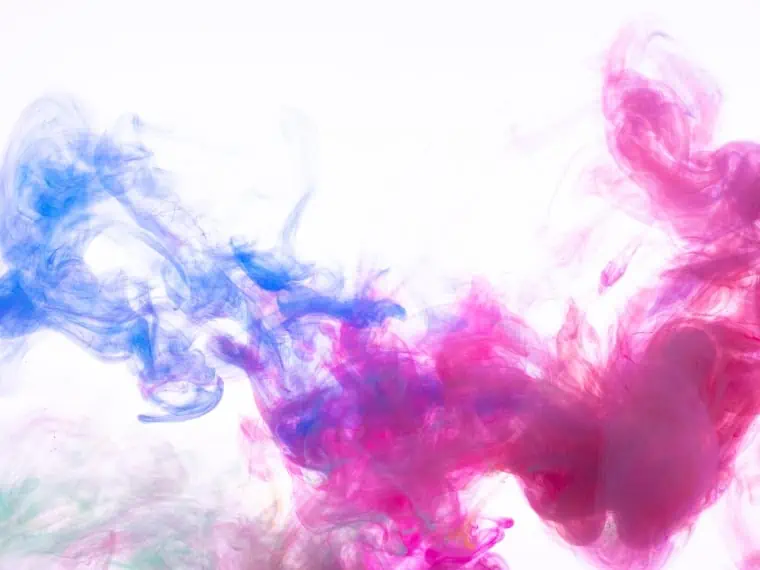
On the other hand, in certain circumstances, it is linked to immaturity, extravagance, and pride.
If you don’t have blue or pink paint at hand, you can make them by mixing other colors.
Pink is a hint of red, so you can make it by mixing the primary color red with white. The more white paint you add to the mixture, the paler the pink will be.
Blue is a primary color in the RYB model and cannot be made by mixing other colors. However, according to subtractive color mixing, you can make blue by mixing the primary colors magenta and cyan of the CMYK color model. If you use an equal proportion, you will get blue.
What Color Do Blue and Pink Make in Lights?
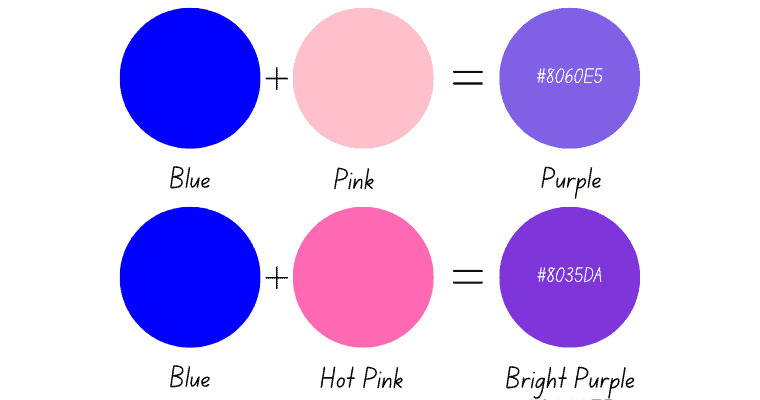
By mixing pink and blue light, you produce purple or violet. The color obtained in RGB space differs depending on the colors’ brightness.
- Pink and blue make a pale purple. Its hex code is #8060E5.
- Hot pink and blue produce a bright purple. Its hex code is #8035DA.
Mixing light differs from mixing paint and pigments because they are two different types of mixing. Light uses additive colors, while pigments use subtractive colors.
Mixing Pink and Blue in the RGB Space
When it comes to light, mixing blue and pink results in a slightly different color because it’s a different type of color mixing.
Thus, the RGB color model is an additive model that uses red, green, and blue as primaries, as opposed to the RYB model, which is a subtractive model that uses red, yellow, and blue as primaries.
The RGB model produces colored lights by mixing primary colors at different intensity levels. So the higher the red, green, and blue values, the brighter the resulting color.
Furthermore, mixing pairs of two primary colors of the RGB space results in the primary colors of the CMYK space.
- Blue and green make cyan
- Blue and red make magenta
- Red and green make yellow
To make the color pink in RGB, you need to mix red and blue light at high intensity while keeping the green light off or at a low level.
The RGB values for pink vary depending on the specific shade you want to achieve.
Still, generally, a combination of red and blue with no green will result in a shade of pink. For example, hot pink has no green in composition.
Assuming the maximum brightness level for each color is 100%, the brightness percentages for pink could range from around 80% red and 50% blue for light pink, to 100% red and 56% blue for a brighter, more saturated pink.
Thus, the more green you add to the pink composition, the darker the purple resulting from mixing pink and blue will be.
Unlike the mixing of primaries in painting that leads to muddy colors, they produce brighter colors in light. Furthermore, when mixed at maximum intensity, all three colors make white light.
Purple versus Violet
Violet is a spectral color in the visible spectrum, ranging from 380 nm to 450 nm. On the other hand, violet is a non-spectral color resulting from the mixture of various combinations of red and blue.
Furthermore, violet consists of more blue, in contrast to purple, which is an equal mixture of blue and red.
Purple
Hex: #800080
Violet
Hex: #8F00FF
How Do Our Eyes Perceive Purple?
Purple is perceived by the human eye as a color that is intermediate between blue and red. It is a non-spectral color, meaning it cannot be generated by a single wavelength of light.
Instead, purple is perceived when red and blue light are combined, either by mixing colored lights or combining pigments in paint.
Physically, purple is perceived by the human eye through a process called “color vision.” This process involves detecting and interpreting light waves by three types of cells in the retina called cones.
Purple is perceived when light wavelengths from the red and blue parts of the spectrum are mixed together in the eye.
Specifically, when light with a wavelength of around 450-480 nanometers (blue) is combined with light with a wavelength of about 620-740 nanometers (red), the brain perceives the color as purple.
Designing With Purple
Purple is a beloved color in art because it is associated with peace, imagination, fantasy, and magic.
Plenty of colors go with purple, including neutrals (gray, white, and black), yellow, blue, or blue-green.
As a designer, however, you must keep color harmony in mind. So whether you’re working on a website or making a logo, use a complementary scheme if you want a contrasting palette.
The complementary color to purple is yellow. If the shade of purple leans more towards red, then it goes with a light green, like chartreuse. If it leans more towards blue, then it goes with orange.
Last Words on What Color Do Pink and Blue Make
So what do you get if you mix blue and pink? When you mix blue and pink, you’ll get a shade of purple. That’s because pink is a tint of red, and mixing the primary colors red and blue makes the secondary color purple.
Purple is a secondary color on the traditional color wheel and comes in different shades. Moreover, it is generally a cool color, like blue.
So, while blending blue and red results in a perfect purple, blue and pink mixed together make a bluish version of purple or even a light purple.
Mixing pink and blue is like mixing the two primary colors – red and blue, which makes purple.
Blue + Pink pigment yields a shade of purple.
Pink + Blue light yields a rich purple or a purple-pink color.
Based on these conclusions, the resulting shades may vary depending on the colors used in the mixture.
Did you like this article about what color blue and pink make when mixed? Share this article with your friends who might be interested.

